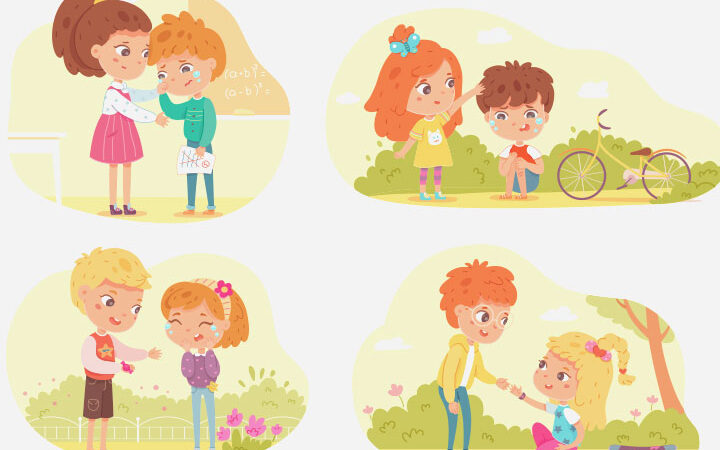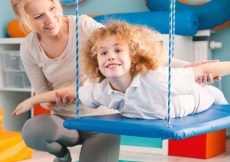Empathy is the ability to sense other people’s feelings or “the ability to put oneself in someone’s shoes.” So, empathy activities for kids are a way to bring kindness and compassion to build relationships. When children learn how other people may feel, they become careful with their actions and words. They tend to empathize or feel the pain the other person is going through and similarly can feel joy in the other person’s happiness. Empathy is relating and mirroring others’ feelings without any selfish motive.
Here, we have compiled a list of empathy activities to teach the importance of kindness to your children.
15 Empathy Activities For Kids
You can practice empathy activities at home or school for children to make positive and strong connections with others.
1. Labeled feelings
Create a scenario and ask the children to label their feelings when put in those situations and how they react. For example, being bullied, witnessing bullying, or being the bullies themselves. They may express anger, rage, sadness, frustration, fear, and pain.
Here you need to explain not to let their emotions overpower them. They need to channel these feelings in the right direction and not act violently. Teach them that situations such as bullying can be stopped if they are empathetic and help each other understand.
2. Photo books
A fun way to understand emotions is by relating them to people’s expressions and different situations. Here, the photo book will have photos of children’s friends and family members where each one is labeled with emotions reflecting the situation or people in the photo. When children go through those photos, they will be able to understand the emotions behind different expressions and situations.
3. Board games
Several board games, such as “friends and neighbors” or “guess how I feel?” help children understand kindness, care, and helpfulness. The former requires to assess the situation displayed on the board and place a card with the action they would perform for the situation. In the latter, they need to guess the other person’s feelings in a given situation. You may get one for your children and play with them to make them aware of others’ feelings.
4. Acts of kindness
As the saying goes, “a simple act of kindness goes a long way,” this activity involves encouraging children to be kind through their actions. Gather the children in a group and begin by asking them about any kind deed they have done and how they feel about it. Next, ask them to do something helpful and kind for another person in the group and have them report to you after they are done.
This helps children reflect upon their actions and understand that kindness makes both the persons receiving it and offering it happy. It will thus motivate them to extend more help and be kind as they grow.
5. The Golden rule
Ask children whether they would like it if they were mocked or made fun of. Or if they were left out of a party when all the others were invited? The answer would be a no. You need to tell them about the golden rule–treat others how you want to be treated. They need to understand that if a particular action or word hurts them, it is not fair for them to do or say the same to someone else. This way, they will develop better and more positive relationships with their friends and peers.
6. Modeling helpfulness
Helping and caring for someone is one of the most significant signs of being empathetic. Make children understand that being insensitive and rude to someone will do no good to either of the persons and instead turn them into enemies. Use examples of stories, movies, books, pictures, or puppet shows to represent helpfulness. Pick the ones that show how respecting others’ feelings and caring for them can induce a sense of joy in both persons.
7. Role play
As the name suggests, the activity requires you to enact a situation and role play. Ask children to act how they will feel and behave in a given situation. For example, if someone broke their toy or yelled at them, or if they found a puppy. If their reactions are justified and acceptable, praise them for being thoughtful and kind. However, if they shout or become aggressive when someone breaks their toy, teach them that such reactions are wrong and can be handled differently and calmly.
Let them know that if someone misbehaved with them, they should first analyze why or what they did and if it was their fault that prompted the other person to break their toy. They should reach out to an elder instead of being rude to that person.
8. Differences and similarities
This activity is a simple and meaningful discussion and exchange of opinions. Gather the children around and start by telling them no two people can be completely similar. Some are taller, some shorter, some are good at outdoor games and some at the indoor ones; some run fast and some slow. These differences make each person unique and should not be weak points.
Let them understand that people with different natures and skills make things exciting and possible to overcome different obstacles when in a group. Most importantly, end the activity by clarifying that although people are different from one another, their feelings are similar, and everybody feels and deserves to be understood.
9. Stories and movies
Visual aids, such as movies, can provide a better teaching medium for children. Many movies for children, such as Inside Out, Zootopia, and E.T., show certain acts of empathy in different situations. Similarly, you can narrate or read stories reflecting the importance of being kind and empathetic. In between, you may pause the story and ask them to define the emotions of that particular scene or a person. This way, they will be able to analyze different situations and behaviors of the characters and learn the right thing to do.
10. Feelings and emotions
Feeling faces display different emotions. You can hang them as postures and have your children identify the emotions on their faces. You can also turn it into a game of feeling faces cards. Draw out a feeling card and let one act out the emotion while the others should guess the correct emotion. This activity can help them understand others’ emotions from their expressions and extend the necessary help.
11. Paper chain of kindness
This is similar to the “act of kindness” activity but is fun and creative. Have the children cut out paper strips and write down any act of kindness they received or offered on that particular day. After filling up the paper strips, staple them together to form a chain and hang them up on the wall. Encourage them to do such kind acts and have them report to you and keep adding it to the chain. You will see the children feel happy when they read them.
12. Stand in my shoes
The children should gather around in a circle with one in the center. Let them all take their shoes off and place them on their front, with the center child placing the shoes on their side.
The child in the center will start by sharing something they are feeling at the moment, such as fear of an upcoming exam or simple joy. Next, others who feel similar will run along with the one at the center and stand behind someone else’s shoe leaving one person at the center at every turn. This will go on until everyone has shared their feelings. This activity can help them relate to and understand one another and thus form a deeper connection.
13. Kindness to animals
Being affectionate and gentle towards animals is one of the essential traits of an empathetic human being. So there are a few activities you can do:
- Have your children take care of their pets by tending to their needs, playing with them, or offering to take the neighbor’s pets for a walk.
- Let them make a bird feeder so the hungry birds can come and eat in peace. You may also encourage them to put water on the balcony on a hot day for the birds.
- Read them a book about being kind to animals so that they can understand their needs, likes, and dislikes.
14. Kindness calendar
It will be like a to-do list of different acts of kindness. List out random acts of kindness, such as helping the elderly, paying for someone else’s meal at a restaurant, saying a few words of encouragement to someone who needs it, and donating toys and clothes. They can tick out each time they accomplish one such deed. This will gradually make them helpful and empathetic.
15. Social awareness
Building social awareness in children could help them be open-minded and empathetic towards others. These activities can help raise social awareness, and you may also try others, such as “listening circles.” Here, divide the children into groups, and in each group, they will answer some get-to-know-you questions. It can be about their favorite animal, things that make them happy, or who they want to be as they grow up. As they exchange answers within themselves, they will be able to understand the other person and can build a strong and positive bond.
Encourage your children to consider others’ feelings and emotions with this collection of empathy activities for kids. While many display sympathy, only a few truly understand the other person’s point of view and empathize. If you teach the noble trait of empathy right from their childhood, they will grow to become humble, respectful, and kind. Now that you have this list make each day learning and meaningful for your children.
Key Pointers
- Children can become kind and mindful of their behavior if they are taught to be empathetic from their childhood.
- Photo books might help them analyze the emotions behind different situations and expressions.
- A paper chain of kindness can act as a daily reminder to be kind and do a good deed every day to spark happiness.
- Feeling faces, standing in my shoes, and watching stories with empathetic activities can nurture your children into humble and gentle individuals.
The following two tabs change content below.





































